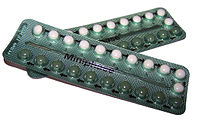
Photo from wikipedia
The relationship between fish eating habits and menstrual pain is unknown. Elucidating this relationship can inform dietary guidance for reproductive age women with menstrual pain. The aim of this study… Click to show full abstract
The relationship between fish eating habits and menstrual pain is unknown. Elucidating this relationship can inform dietary guidance for reproductive age women with menstrual pain. The aim of this study was to clarify the relationship between fish intake frequency/preference and menstrual pain. This cross-sectional study was conducted at the Miyagi Regional Center as an adjunct study of the Japan Environment and Children’s Study, and 2060 eligible women (mean age, 31.9 years) participated. Fish intake frequency (“< 1 time/week,” “1 time/week,” “2–3 times/week,” or “≥ 4 times/week”), preference (“like,” “neutral,” or “dislike”), and menstrual pain (no/mild or moderate-to-severe) were assessed at 1.5 years after the last delivery through self-administered questionnaires. The association between fish intake frequency/preference and prevalence of moderate-to-severe menstrual pain was evaluated through logistic regression analyses. Our results show that, compared with the “< 1 time/week” (38.0%) group, the “1 time/week” (26.9%), “2–3 times/week” (27.8%), and “≥ 4 times/week” (23.9%) groups showed a lower prevalence of moderate-to-severe menstrual pain (p < 0.01). The prevalence of moderate-to-severe menstrual pain was 27.7%, 27.6%, and 34.4% in the “like,” “neutral,” and “dislike” groups, respectively. Multivariate logistic regression showed that frequent fish intake was associated with a lower prevalence of moderate-to-severe menstrual pain (“1 time/week”: odds ratio [OR] = 0.59; 95% confidence interval [CI], 0.41–0.86, “2–3 times/week”: OR = 0.64; 95% CI, 0.45–0.90 and “≥ 4 times/week”: OR = 0.52; 95% CI, 0.34–0.80; trend p = 0.004). Multivariate logistic regression showed no association between fish preference and moderate-to-severe menstrual pain (“dislike” vs “like”: OR = 1.16; 95% CI, 0.78–1.73). There was a significant negative association between fish intake frequency and menstrual pain. It is suggested that fish intake can reduce or prevent menstrual pain.
Journal Title: PLoS ONE
Year Published: 2022
Link to full text (if available)
Share on Social Media: Sign Up to like & get
recommendations!